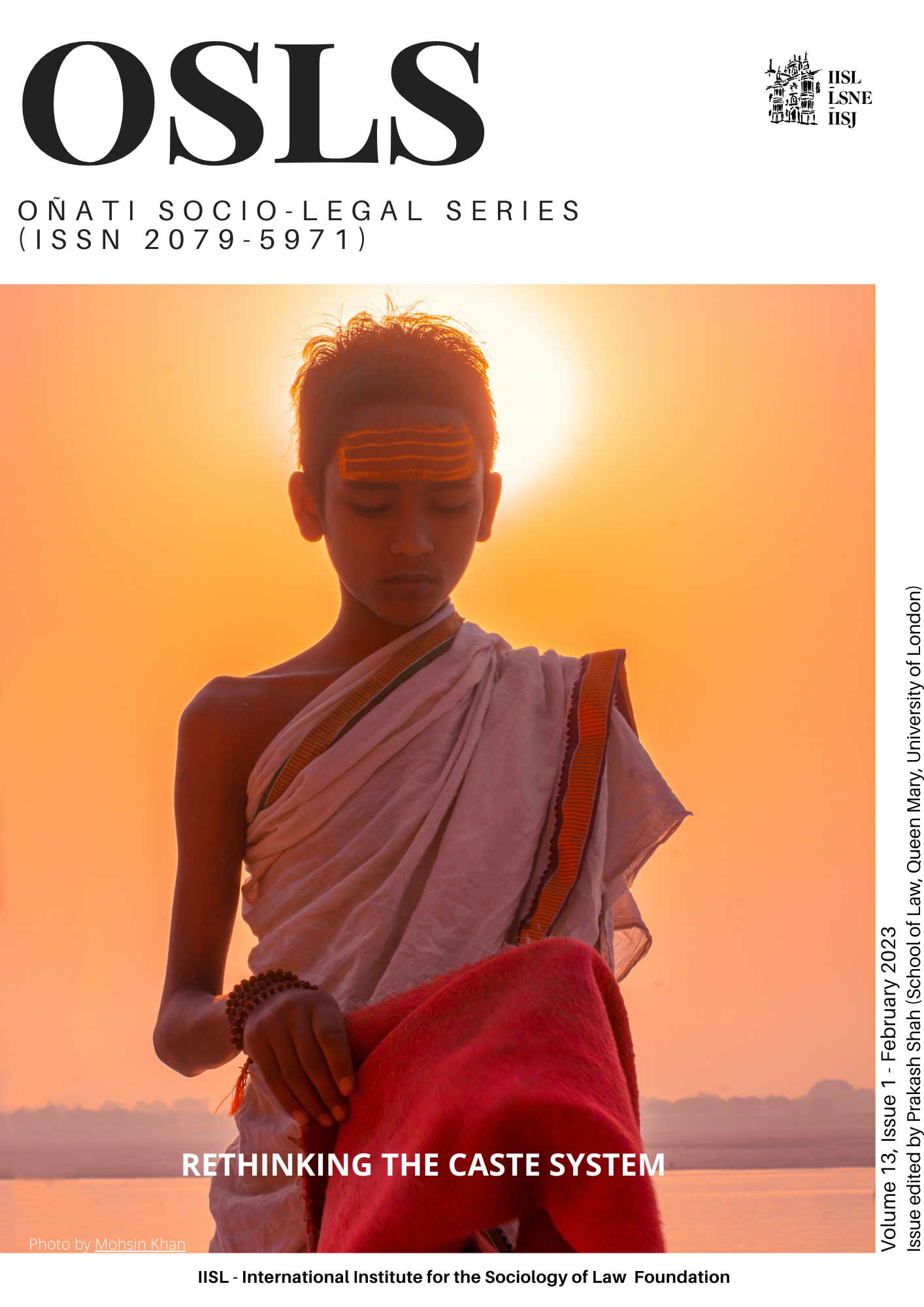Caste, race, and slavery
On comparisons between race in the United States and caste in India, and to forgotten assumptions behind the legal categories
DOI:
https://doi.org/10.35295/osls.iisl/0000-0000-0000-1330Keywords:
caste, race, slavery, comparative science of cultures, Anglo-Hindu law, Enlightenment evolutionary thoughtAbstract
While diving into the background ideas about caste and race as legal categories, a researcher will discover an important disagreement between scholars: For some, caste is certainly connected with race, whereas for others, caste and race are separate concepts which refer to distinct realities. The aim of this article is twofold: To consider the validity of several characteristics which are ascribed by many authors as common to caste and race, and to analyse background assumptions that enabled the comparison between caste and race as such. The important question, connected with both these aims is about the emergence of the idea that the ancient “Hindu nation” was divided into two peoples, and castes as a system are reflecting the original division in modern India. We will closely examine comparisons made between the advent of Aryans in India and slavery in the United States and Africa. Finally, we will reconsider the European ideas of human evolution and equality of men, which served as a contrasting board for explanations of caste as a form of slavery.
Downloads
Metrics
Global Statistics ℹ️
|
2682
Views
|
4610
Downloads
|
|
7292
Total
|
|
References
Adluri, V., and Bagchee, J., 2014. The Nay Science: A History of German Indology. Oxford/New York: Oxford University Press. DOI: https://doi.org/10.1093/acprof:oso/9780199931347.001.0001
Alexander, M., 2020. The New Jim Crow: Mass Interaction in the Age of Colorblindness. (The Tenth Anniversary Edition). New York/London: The New Press.
Allison, D., Gardner, B.B., and Gardner, M.R., 1941. Deep South: A Social Anthropological Study of Caste and Class. Chicago University Press.
Ambedkar, B., 1989. Book I. Untouchables or the Children of India’s Ghetto. In: V. Moon, ed., Dr. Babasaheb Ambedkar, Writings and Speeches (Vol. 5). Bombay: Education Department, Government of Maharashtra, pp. 3–125.
Ambedkar, B., 2002. Which Is Worse? Slavery or Untouchability? In: V. Moon, ed., Dr. Babasaheb Ambedkar, Writings and Speeches (Vol. 5). Bombay: Education Department, Government of Maharashtra, pp. 741–759.
Anderson, E., et al., 2012. The Legacy of Racial Caste: An Exploratory Ethnography. The Annals of the American Academy of Political and Social Science, no. 642, pp. 25–42. DOI: https://doi.org/10.1177/0002716212437337
Aston, N.M., ed., 2001. Literature of Marginality: Dalit Literature and African American Literature. New Delhi: Prestige Books.
Bates, C., 1995. Race, Caste and Tribe in Central India: The early origins of Indian anthropometry. In: P. Robb, ed., The Concept of Race in South Asia. Delhi: Oxford University Press, pp. 219–259.
Bayly, S., 1999. Caste, Society and Politics in India from the Eighteenth Century to the Modern Age. Cambridge University Press. DOI: https://doi.org/10.1017/CHOL9780521264341
Bernasconi, R., and Cook, S., eds., 2003. Race and Racism in Continental Philosophy. Bloomington/Indianapolis: Indiana University Press.
Berreman, G.D., 1960. Caste in India and the United States. American Journal of Sociology, 66(2), pp. 120–127. DOI: https://doi.org/10.1086/222839
Berreman, G.D., 1967. Structure and Function of Caste Systems. In: G. De Vos and H. Wagatsuma, eds., Japan’s Invisible Race: Caste in Culture and Personality. Berkeley: University of California Press, pp. 277–307. DOI: https://doi.org/10.1525/9780520310841-022
Berreman, G.D., 1979. Caste and Other Inequities: Essays on Inequality. Meerut: Ved Prakash Vatuk, Folklore Institute.
Béteille, A., 1990. Race, Caste and Gender. Man. New Series, 25(3), pp. 489–504. DOI: https://doi.org/10.2307/2803715
Béteille, A., 2001. Race and Caste. The Hindu, 10 March.
Bouglé, C., 1971. Essays on the Caste System by Célestin Bouglé. Translated with an introduction by D. F. Pockock, Reader in Social Anthropology and Dean of the School of African and Asian Studies University of Sussex. Cambridge University Press.
Brace, C.L., 1863. The Races of the Old World: A Manual of Ethnology. New York: Charles Scribner.
Bryant, E., and Patton, L.L., eds., 2005. The Indo-Aryan Controversy. London: Routledge. DOI: https://doi.org/10.4324/9780203641880
Buchanan, F., 1799. On the Religion and the Literature of the Burmas. Asiatic Researches, no. 6, pp. 163–308.
Census of India, Vol. XVII, 1901. The Punjab, its Feudatories, and the North-West Frontier Province, Part I., The Report on the Census by H.A. Rose, 1902. Simla: Government Central Printing Office.
Chandrasekhar, S., 1946. Caste, Class, and Color in India. The Scientific Monthly, 62(2), pp. 151–157.
Colebrooke, H.T., 1839. Notices of the Life of Henry Thomas Colebrooke, Esq. by His Son. The Journal of the Royal Asiatic Society of Great Britain and Ireland, 5(1), pp. 1–60. DOI: https://doi.org/10.1017/S0035869X00015112
Colebrooke, H.T., 1873a. Miscellaneous Essays, with the life of the author by his son, Sir T.E. Colebrooke (vol. I). London: Trübner & Co.
Colebrooke, H.T., 1873b. Miscellaneous Essays by H. T. Colebrooke. A New Edition, with Notes by E.B. Cowell (Vol. II). London: Trübner & Co.
Cox, O.C., 1945. Race and Caste: A Distinction. American Journal of Sociology, 50(5), pp. 360–368. DOI: https://doi.org/10.1086/219653
Cox, O.C., 1959. Caste, Class & Race. A Study in Social Dynamics. New York: Monthly Review Press.
Curzon, A., 1856. On the original extension of the Sanskrit language over certain portions of Asia and Europe; and on the Ancient Aryans, Indians, or Hindus of India Proper. Journal of the Royal Asiatic Society of Great Britain and Ireland, 16, pp. 172–200. DOI: https://doi.org/10.1017/S0035869X00156321
De Reuck, A., and Knight, J., eds., 1967. Caste and Race: Comparative Approaches. London: J. & A. Churchill.
De Roover, J., 2017a. A Nation of Tribes and Priests: The Jews and the Immorality of the Caste System. In: M. Fárek et al., eds., Western Foundations of the Caste System. Cham: Palgrave Macmillan, pp. 173–220. DOI: https://doi.org/10.1007/978-3-319-38761-1_6
De Roover, J., 2017b. Scheduled Castes vs. Caste Hindus: About a Colonial Distinction and Its Legal Impact. Socio-Legal Review, 13(1), pp. 22–52. DOI: https://doi.org/10.55496/DLUQ9063
De Roover, J., and Claerhout, S., 2015. The Caste Connection: On the Sacred Foundations of Social Hierarchy. Theatrum Historiae, 17, pp. 9–36.
Deliége, R., 2011. Caste, Class, and Untouchability. In: I. Clark-Decès, ed., A Companion to the Anthropology of India. London: Blackwell, pp. 45–61. DOI: https://doi.org/10.1002/9781444390599.ch2
Desai, M., 2015. Caste in Black and White: Dalit Identity and the Translation of African American Literature. Comparative Literature, 67(1), pp. 94–113. DOI: https://doi.org/10.1215/00104124-2862043
Dollard, J., 1937. Caste and Class in a Southern Town. New York: Doubleday & Co.
Dow, A., 1772. The History of Hindoostan, translated from the Persian. To Which are Prefixed Two Dissertations: The First Concerning the Hindoos, and the Second on the Origin and Nature of Despotism. London: T. Becket and P.A. De Hondt.
Fárek, M., 2021. India in the Eyes of Europeans: Conceptualization of Religion in Theology and Oriental Studies. Prague: Charles University Press. DOI: https://doi.org/10.2307/jj.1544748
Fárek, M., et al., eds., 2017. Western Foundations of the Caste System. Cham: Palgrave Macmillan. DOI: https://doi.org/10.1007/978-3-319-38761-1
Forbes, J.D., 1983. Mustees, Half-Breeds and Zambos in Anglo North America: Aspects of Black-Indian Relations. American Indian Quarterly, 7(1), pp. 57–83. DOI: https://doi.org/10.2307/1183882
Fuller, C.J., 2011. Caste, Race, and Hierarchy in the American South. The Journal of the Royal Anthropological Institute, 17(3), pp. 604–621. DOI: https://doi.org/10.1111/j.1467-9655.2011.01709.x
Ghurye, G.S., 1957. Caste and Class in India. Bombay: Popular Press. (Originally published as Ghurye, G S., 1932. Caste and Race in India. London: Kegan, Paul & Co.).
Gidla, S., and Horn, A., 2021. Caste, Race – and Class. New Left Review [online], 131, pp. 15–35. Available from: https://newleftreview.org/issues/ii131/articles/sujatha-gidla-alan-horn-caste-race-and-class [Access 28 July 2022].
Gurawa, A., and Chauhan, V.S., 2021. Comparative analysis of Dr. Ambedkar slavery and untouchability which is worst and Fredric Douglass slaves narratives. International Journal of Advanced Academic Studies [online], 3(1), pp. 341–344. Available from: https://www.allstudyjournal.com/article/505/3-1-57-905.pdf [Access 28 July 2022]. DOI: https://doi.org/10.33545/27068919.2021.v3.i1e.505
Harper, E.B., 2007. Caste: The United States and India. In: M. Singer and B.S. Cohn, eds., Structure and Change in Indian Society. New Brunswick/London: Aldine Transaction, pp. 51–77. (Originally published in 1968).
Hock, H.H., 2005. Philology and the Historical Interpretation of the Vedic Texts. In: E. Bryant and L.L. Patton, eds., The Indo-Aryan Controversy. London: Routledge, pp. 282–308.
Holwell, J.Z., 1779. A Review of the Original Principles, Religious and Moral, of the Ancient Brahmins. London: Vernor.
Ibbetson, D., 1916. Panjab Castes. Lahore: Superintendent, Government Printing.
Jalki, D., and Pathan, S., 2015. On the Difficulty of Refuting or Confirming the Arguments about the Caste System. Theatrum Historiae [online], 17, pp. 37–61. Available from: https://www.researchgate.net/publication/311229969_On_the_Difficulty_of_Refuting_or_Confirming_the_Arguments_about_the_Caste_System [Access 28 July 2022].
Jalki, D., and Pathan, S., 2017. Are There Caste Atrocities in India? What the Data Can and Cannot Tell Us. In: M. Fárek et al., eds., Western Foundations of the Caste System, Cham: Palgrave Macmillan, pp. 57-84. DOI: https://doi.org/10.1007/978-3-319-38761-1_3
Kaur, N., 2001. Caste and Race. Frontline: India’s National Magazine [online], 23 June. Available from: https://frontline.thehindu.com/the-nation/article30251084.ece [Access 28 July 2022].
Keppens, M., 2017. The Aryans and the ancient system of caste. In: M. Fárek et al., eds., Western Foundations of the Caste System. Cham: Palgrave Macmillan, pp. 221–251. DOI: https://doi.org/10.1007/978-3-319-38761-1_7
Kudekallu, R.J., 2020. Race, Caste, and Hunger. Fordham International Law Journal [online], 43(4), pp. 1103–1131. Available from: https://ir.lawnet.fordham.edu/ilj/vol43/iss4/7 [Access 28 July 2022].
LaBrack, B., 1973. The Concept of Caste: Cross-Cultural Applications. Transactions of the Nebraska Academy of Sciences and Affiliated Societies [online], 383, pp. 48–56. Available from: https://digitalcommons.unl.edu/tnas/383 [Access 28 July 2022].
Leopold, J., 1974. British Applications of the Aryan Theory of Race to India, 1850–1870. The English Historical Review 89(352), pp. 578–603. DOI: https://doi.org/10.1093/ehr/LXXXIX.CCCLII.578
Macdonell, A.A., 1914. The Early History of Caste. The American Historical Review [online], 19(2), pp. 230–244. Available from: https://doi.org/10.2307/1862285 [Access 28 July 2022]. DOI: https://doi.org/10.2307/1862285
Myrdal, G., 1944. An American Dilemma: The Negro Problem and Modern Democracy. New York: Harper & Brothers.
Nesfield, J.C., 1885. Brief View of the Caste System of the North-Western Provinces an Oudh. Allahabad: North-Western Provinces and Oudh Government Press.
Olender, M., 1992. The Language of Paradise: Race, Religion and Philology in the Nineteenth Century. Cambridge, MA/London: Harvard University Press.
Pandey, G., 2013. A History of Prejudice: Race, Caste, and Difference in India and the United States. New Delhi: Cambridge University Press. DOI: https://doi.org/10.1017/CBO9781139237376
Pertold, O., 1927. Ze zapomenutých koutů Indie [From the Forgotten Corners of India]. Prague: Aventinum.
Poliakov, L., 1996. The Aryan Myth: A History of Racist and Nationalist Ideas in Europe. New York: Barnes and Noble.
Population of the United States in 1860, Compiled from the Original Returns of the Eight Census, 1864. Washington: Government Printing Office.
Quigley, D., 1993. The Interpretation of Caste. Oxford: Clarendon Press.
Rajan, V., 2020. Dalits and the Caste System of India. Some Explorations and Conjectures [online]. Porto/Grenzach-Whylen: Transcend. Available from: https://www.transcend.org/tri/downloads/The_Caste_System_in_India.pdf [Access 28 July 2022].
Reddy, D.S., 2005. The Ethnicity of Caste. Anthropological Quarterly [online], 78(3), pp. 543–584. Available from: https://www.academia.edu/751153/_The_Ethnicity_of_Caste_Deepa_S_Reddy_University_of_Houston_Clear_Lake_Anthropological_Quarterly_78_3_2005_543_584 [Access 28 July 2022]. DOI: https://doi.org/10.1353/anq.2005.0038
Risley, H.H., 1915. The People of India. Calcutta/Simla/London: Thacker and Spink.
Schermerhorn, R.A., 1972. A Note on the Comparative View of Caste. Phylon, 33(3), pp. 254–259. DOI: https://doi.org/10.2307/273525
Sénart, É., 1930. Caste in India. The Facts and the System. London: Methuen & Co.
Shah, P., 2015. An Ancient System of Caste: How the British Law depends on Orientalism. Theatrum Historiae [online], 17, pp. 119–142. Available from: https://www.academia.edu/25363346/_An_ancient_system_of_caste_How_the_British_law_against_caste_depends_on_Orientalism [Access 28 July 2022].
Shah, P., 2017a. Dissimulating on Caste in British Law. In: M. Fárek et al., eds., Western Foundations of the Caste System. Cham: Palgrave Macmillan, pp. 85–126. DOI: https://doi.org/10.1007/978-3-319-38761-1_4
Shah, P., 2017b. Orientalism, Multiculturalism, and Identity Politics: Hindus and the British Caste Law. Quaderni di Diritto e Politica Ecclesiastica [online], Special Issue: Daimon. Diritto Comparato delle Religioni, pp. 343–357. Available from: https://www.academia.edu/48956244/Shah_final_published_version [Access 28 July 2022].
Sharma, U., 1993. Berreman Revisited; Caste and the Comparative Method. The Sociological Review, 41(1), pp. 72–91. DOI: https://doi.org/10.1111/j.1467-954X.1993.tb03401.x
Sinha, M., 2007. Specters of Mother India: The Global Restructuring of an Empire. Durham: Duke University Press. DOI: https://doi.org/10.2307/j.ctv11hph5z
Slate, N., 2011. Colored Cosmopolitanism: The Shared Struggle for Freedom in the United States and India. Cambridge, MA: Harvard University Press. DOI: https://doi.org/10.4159/harvard.9780674062962
Stepan, N., 1982. The Idea of Race in Science: Great Britain 1800–1960. London: Macmillan. DOI: https://doi.org/10.1007/978-1-349-05452-7
Stevenson, H.N.C., 1954. Status Evaluation in the Hindu Caste System. The Journal of the Royal Anthropological Institute of Great Britain and Ireland 84(1–2), pp. 45–65. DOI: https://doi.org/10.2307/2844000
Subedi, M., 2013. Some Theoretical Considerations on Caste. Dhaulagiri Journal of Sociology and Anthropology [online], 7, pp. 51–86. Available from: https://doi.org/10.3126/dsaj.v7i0.10437 [Access 28 July 2022]. DOI: https://doi.org/10.3126/dsaj.v7i0.10437
Sussman, R.N., 2014. The Myth of Race: The Troubling Persistence of an Unscientific Idea. Cambridge, MA/London: Harvard University Press. DOI: https://doi.org/10.4159/harvard.9780674736160
Tanwar, A., 2013. Historical Interpretations of Brahmin Dominance (With Special Reference to the Theory of Origins of the Aryans and Shudras. Bharatiya Bhasha, Shiksha, Sahitya evam Shodh [online], 4(2), pp. 181–195. Available from: https://www.academia.edu/11998826/Historical_Interpretations_of_Brahmin_Dominance_With_Special_Reference_to_the_Theory_of_Origins_of_the_Aryans_and_the_Shudras [Access 28 July 2022].
Thakrar, A., 2001. The Origins of the Caste System in India Vs. (and how it relates to) Formation of Race in America. Undergraduate Review [online], 13(1), pp. 1–10. Available from: https://digitalcommons.iwu.edu/rev/vol13/iss1/4 [Access 28 July 2022].
Trautmann, T.R., 1997. Aryans and British India. Berkeley/Los Angeles: University of California Press. DOI: https://doi.org/10.1525/california/9780520205468.001.0001
Trautmann, T.R., 2006. Languages & Nations: The Dravidian Proof in Colonial Madras. Berkeley/Los Angeles: University of California Press. DOI: https://doi.org/10.1525/9780520931909
Trautmann, T.R., ed., 2005. The Aryan Debate. New Delhi: Oxford University Press.
Warner, W.L., 1936. American caste and class. American Journal of Sociology, 42(2), pp. 234–237. DOI: https://doi.org/10.1086/217391
Wilkerson, I., 2020. Caste: The Origins of Our Discontent. New York: Random House.
Downloads
Published
How to Cite
Issue
Section
License
Copyright (c) 2022 Martin Fárek

This work is licensed under a Creative Commons Attribution-NonCommercial-NoDerivatives 4.0 International License.
OSLS strictly respects intellectual property rights and it is our policy that the author retains copyright, and articles are made available under a Creative Commons licence. The Creative Commons Non-Commercial Attribution No-Derivatives licence is our default licence and it regulates how others can use your work. Further details available at https://creativecommons.org/licenses/by-nc-nd/4.0 If this is not acceptable to you, please contact us.
The non-exclusive permission you grant to us includes the rights to disseminate the bibliographic details of the article, including the abstract supplied by you, and to authorise others, including bibliographic databases, indexing and contents alerting services, to copy and communicate these details.
For information on how to share and store your own article at each stage of production from submission to final publication, please read our Self-Archiving and Sharing policy.
The Copyright Notice showing the author and co-authors, and the Creative Commons license will be displayed on the article, and you must agree to this as part of the submission process. Please ensure that all co-authors are properly attributed and that they understand and accept these terms.























